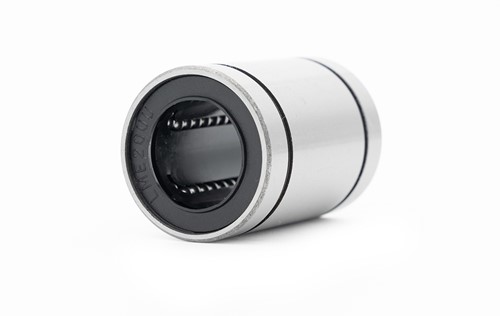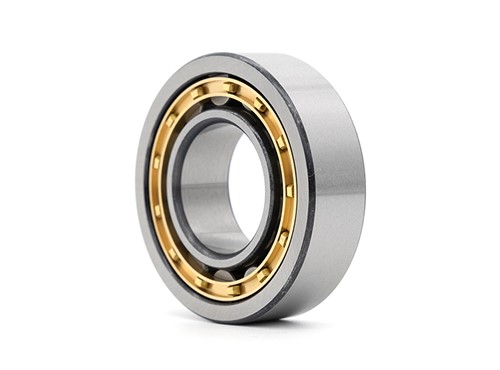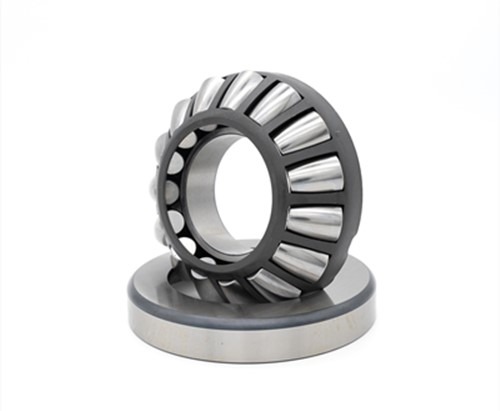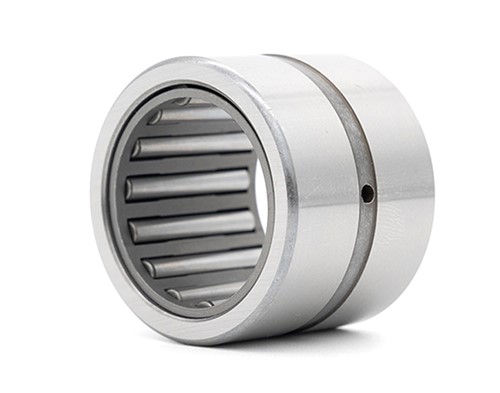
Bearings are an important part of contemporary machinery and equipment. According to the contact method of rolling elements and raceways, we divide them into ball bearings, roller bearings and sliding bearings. Its main function is to support the mechanical rotating body, reduce the friction coefficient during its movement, and ensure its rotation accuracy.
It can be used in all kinds of machinery and equipment, automobiles, motorcycles, household appliances, port equipment, ship and military industry, aerospace, agricultural machinery, construction machinery, wind power generation, transmission equipment, logistics and transportation and other fields.
Ball bearing is a kind of rolling bearing. The ball is installed between the inner ring and the outer ring and can bear a large load. The ball bearing types include deep groove ball bearings, angular contact ball bearings, self-aligning ball bearings, thrust ball bearings, linear ball bearings, pillow block bearings with housing, bidirectional thrust angular contact ball bearings, etc.
1. Deep groove ball bearings

Deep groove ball bearings are the most representative rolling bearings. Compared with other types of bearings of the same size, this type of bearing has low friction coefficient, high limit speed, simple structure, low manufacturing cost, high precision, no need for frequent maintenance, large size range and many forms, and it is the most widely used type. Bearing. It mainly bears radial load, but also can bear certain axial load. When it only bears radial load, the contact angle is zero.
2. Angular Contact Ball Bearings

Angular Contact Ball Bearings can bear radial load and axial load at the same time. It can work at higher speeds. The larger the contact angle, the higher the axial load carrying capacity. The contact angle is the angle between the line of contact points between the ball and the raceway in the radial plane and the vertical line of the bearing axis. High-precision and high-speed bearings usually take a contact angle of 15 degrees. Under the action of axial force, the contact angle will increase. The accuracy grades of angular contact ball bearings include dimensional tolerances and rotation accuracy. The accuracy from low to high is expressed as P0, P6, P5, P4, P2, Or ABEC-1, ABEC-3, ABEC-5, ABEC-7, ABEC-9 Grade level.
3. Self-aligning ball bearing

A self-aligning ball bearing is a bearing equipped with spherical balls between the inner ring of two raceways and the outer ring whose raceways are spherical. The curvature center of the outer ring raceway surface is consistent with the bearing center, so it has the same centering function as the self-aligning ball bearing. When the shaft or housing is deflected, it can be adjusted automatically without increasing the bearing burden. Spherical roller bearings can bear radial load and axial load in two directions. Self-aligning ball bearings have large radial load capacity and are suitable for heavy loads and shock loads. The inner diameter of the inner ring is a bearing with a tapered bore, which can be directly installed. Or use an adapter sleeve or a disassembly tube to install it on the cylindrical shaft. The cage is made of steel stamping cage and polyamide forming. Self-aligning ball bearings are suitable for bearing heavy loads and impact loads.
4. Thrust ball bearing

Thrust ball bearings are divided into one-way and two-way. They can only bear axial load and must not bear any radial load. Thrust bearings are divided into two parts: tight ring and live ring. The tight ring and the shaft sleeve are tight, and the live ring is supported on the bearing seat. Rings and rolling elements are usually made of rolling bearing steel with high strength and good wear resistance, and the surface hardness after quenching should reach HRC60-65. The cage is mostly made of mild steel stamping, and it can also be made of copper alloy laminated bakelite or plastic.
5. Linear Bearings

Linear bearings are divided into metal linear bearings and plastic linear bearings.
Metal linear bearing is a linear motion system produced at low cost for use with a cylindrical shaft with an infinite stroke. Since the bearing ball is in point contact with the shaft, the load is small. The steel ball rotates with very little frictional resistance, so as to obtain high-precision smooth movement.
Plastic linear bearing is a kind of linear motion system with self-lubricating characteristics. The biggest difference between metal linear bearing and metal linear bearing is that the metal linear bearing has rolling friction, and the bearing and the cylindrical shaft are in point contact, so this is suitable for low-load and high-speed movement; Plastic linear bearings have sliding friction, and there is surface contact between the bearing and the cylindrical shaft, so this type of bearing is suitable for high-load, low-speed movement.
6. Pillow Block bearing with housing

Pillow Block Bearing with housing is a kind of bearing unit that combines rolling bearing with housing. Most of the outer spherical bearings are made of a spherical outer diameter, and are installed together with an imported bearing housing with a spherical inner hole. The structure is diverse, and the versatility and interchangeability are good. At the same time, this type of bearing also has a certain degree of alignment in design, is easy to install, and has a dual-structure sealing device that can work in harsh environments. The bearing housing is generally formed by casting. Commonly used seats are vertical pillow block (P), square pillow block (F), Square-Flanged pillow block (FS), Square-Flanged pillow block (FC), two-bolt flanged housing (FL), UCC pillow block (C), UCT pillow block (T ).
7. Bidirectional thrust angular contact ball bearings
The contact angle of thrust angular contact ball bearings is generally 60°. Commonly used thrust angular contact ball bearings are generally two-way thrust angular contact ball bearings, which are mainly used for precision machine tool spindles. They are generally used in conjunction with double-row cylindrical roller bearings and can withstand two-way shafts. To load, it has the advantages of high precision, good rigidity, low temperature rise, high speed, convenient assembly and disassembly, etc.
Roller bearing is a kind of rolling bearing, and it is one of the parts widely used in modern machinery. It relies on the rolling contact between the main components to support the rotating parts. Roller bearings are now mostly standardized. Roller bearings have the advantages of small starting torque, high rotation accuracy, and convenient selection. The main types of roller bearings are tapered roller bearings, cylindrical roller bearings, spherical roller bearings, thrust roller bearings, needle roller bearings, etc.
1. Tapered Roller Bearings

Tapered roller bearings are separable bearings. Both the inner and outer rings of the bearing have tapered raceways. This type of bearing is divided into single-row, double-row and four-row tapered roller bearings according to the number of rows installed. Single row tapered roller bearings can bear radial load and single direction axial load. When the bearing bears radial load, it will produce an axial component force, so when it needs another bearing that can bear the axial force in the opposite direction to balance it.
2. Cylindrical roller bearing

Cylindrical roller Bearing, Cylindrical Rollers and raceways are linear contact bearings. Load capacity, mainly bear radial load. The friction between the rolling element and the retaining edge of the ring is small, which is suitable for high-speed rotation. According to whether the ring has ribs, it can be divided into single row cylindrical roller bearings such as NU, NJ, NUP, N, NF, and double row cylindrical roller bearings such as NNU and NN. The bearing has a separable structure with inner ring and outer ring
3. Spherical roller bearing

Spherical roller bearings have two rows of symmetrical spherical rollers, which mainly bear radial loads, and can also bear axial loads in any direction, but cannot bear pure axial loads. The outer ring raceway of this type of bearing is spherical, so it has good alignment performance and can compensate for coaxiality errors. The bearing can still be used normally when the shaft is bent or installed out of center. The alignment varies with the bearing size series. , Generally, the allowable alignment angle is 1~2.5 degrees. This type of bearing has a large load capacity. In addition to the radial load, the bearing can also withstand the axial load acting in both directions. It has good impact resistance. In other words, the allowable working speed of the spherical roller bearing is relatively low. Suitable for working under heavy load or vibration load.
4. Thrust roller bearing

Including thrust cylindrical roller bearings, thrust tapered roller bearings, thrust needle roller bearings and thrust spherical roller bearings
Type 29000 bearing rollers are asymmetrical spherical rollers, which can reduce the relative sliding of the rollers and raceways during work, and the rollers are long, large in diameter, large in number of rollers, and high in load capacity. They are usually lubricated by oil. Grease lubrication can be used in individual low speed situations. When designing and selecting, it should be preferred;
Type 80000 thrust cylindrical roller bearings, type 90000 thrust tapered roller bearings and AXK type thrust needle roller bearings can withstand unidirectional axial load. It has a much larger axial load capacity than thrust ball bearings, and has greater rigidity. Occupies little axial space.
Thrust cylindrical roller bearings and thrust tapered roller bearings are suitable for low-speed occasions. The speed of thrust tapered roller bearings is slightly higher than that of thrust cylindrical roller bearings. Thrust cylindrical roller bearings are separable bearings, which can only bear one-way axial load and slight impact, and can limit the axial displacement of the shaft (or housing) in one direction, so it can be used for one-way axial positioning. But its carrying capacity is far greater than that of thrust ball bearings. When the roller is rolling, due to the different linear speeds at the two ends of the roller, the roller will inevitably slide on the raceway of the ring. Therefore, the limit speed of this type of bearing is lower than that of the thrust ball bearing, and it is usually only suitable for low-speed operation.
The standard design of thrust cylindrical roller bearing adopts a car-made metal solid cage. According to user requirements, cages of other types or materials can also be used. Thrust tapered roller bearings can only bear one-way axial load and can limit the one-way axial displacement of the bearing, so it can be used for one-way axial positioning. Compared with thrust cylindrical roller bearings, the bearing capacity is large, the relative sliding is small, but the limit speed is lower.
5. Needle roller bearings

Needle roller bearings are equipped with thin and long rollers (the length of the roller is 3-10 times the diameter, and the diameter is generally not greater than 5mm), so the radial structure is compact, and its inner diameter and load capacity are the same as other types of bearings. The smallest diameter, especially suitable for supporting structures with limited radial installation dimensions. Needle roller bearings can be used without inner ring bearings or needle roller and cage assemblies according to different applications. At this time, the journal surface and housing that match the bearing The hole surface is directly used as the inner and outer rolling surface of the bearing. To ensure the load capacity and running performance are the same as the bearing with ring, the hardness, machining accuracy and surface quality of the raceway surface of the shaft or housing hole should be combined with the bearing ring. The needle bearing is a bearing unit composed of radial needle roller bearings and thrust bearing components. It has a compact structure and small size, high rotation accuracy, and can bear a certain axial load while bearing a high radial load.
6. Combined bearing

A rolling bearing composed of two or more bearing structures in a set of bearings at the same time. Such as needle roller and thrust cylindrical roller combined bearings, needle roller and thrust ball combined bearings, needle roller and angular contact ball combined bearings, etc.
7. Flange bearing
Flange bearings are provided with flanged flanges on the outer wheel. The feature is that it can simplify the structure of the host, reduce the size of the host, and make the bearing easier to locate.
Sliding bearing is a bearing that works under sliding friction. The sliding bearing works smoothly, reliably and without noise. Under the condition of liquid lubrication, the sliding surface is separated by lubricating oil without direct contact, and friction loss and surface wear can be greatly reduced. The oil film also has a certain vibration absorption capacity. But the starting frictional resistance is relatively large. The part of the shaft supported by the bearing is called the journal, and the parts that match the journal are called the bearing bush. In order to improve the friction properties of the bearing pad surface, the anti-friction material layer cast on the inner surface is called the bearing liner. The materials of bearing bushes and bearing linings are collectively referred to as sliding bearing materials. Sliding bearing applications are generally under high-speed and light-load conditions

①According to the direction that can bear the load, it can be divided into two types: radial (centripetal) sliding bearings and thrust (axial) sliding bearings.
②According to the type of lubricant, it can be divided into 7 categories: oil lubricated bearings, grease lubricated bearings, water lubricated bearings, gas bearings, solid lubricated bearings, magnetic fluid bearings and electromagnetic bearings.
③According to the thickness of the lubricating film, it can be divided into two types: thin-film lubricated bearings and thick-film lubricated bearings.
④According to the bearing material, it can be divided into bronze bearings, cast iron bearings, plastic bearings, gem bearings, powder metallurgy bearings, self-lubricating bearings and oil-impregnated bearings.
⑤According to the bearing structure, it can be divided into round bearing, elliptical bearing, three-oil-blade bearing, stepped surface bearing, tilting shoe bearing and foil bearing, etc.

















